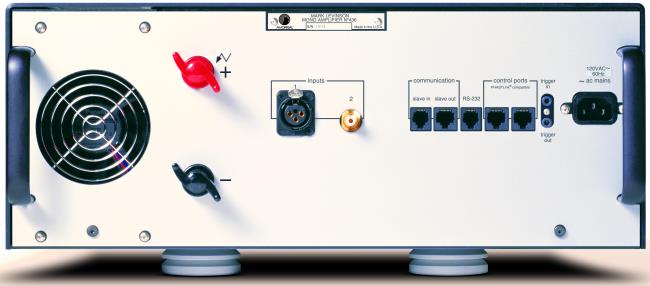Introduction
Following on our recent review of the
Mark Levinson No 326S Preamplifier, we now review the
No 433 three-channel (200 watts per channel) and No
436 (350 watts monoblock) power amplifiers.
The No 436 is several years old, while the No
433 is new, reflecting the current interest in home theater.
There is also a No 431 which is a dual-mono design,
with 200 watts per channel output, and a No 432, with 400
watts per channel output.
The Design
The No 433 has three channels, each rated at 200 watts
RMS into 8 ohms. Each channel has its own power supply, using a separate
toroidal power transformer and two low ESR power supply capacitors. It is
also called a triple-mono design.
Large copper bus bars handle power distribution, and each amplifier
channel is fully balanced from input to output. The PC board layout of each
leg of the amplifier signal is mirror imaged so as to cancel magnetic
fields.
The No 433 and No 436 share some of
the same design characteristics, such as Adaptive Bias (controls the amount
of Class A bias) and being fully balanced.
The No 436 is,
obviously, a much more powerful amplifier. It has a huge toroidal power
transformer, rated at 2372 VA (more than 2,000 watts), for its specified 350
watts output into 8 ohms. It also has 80,000
µF of power supply capacitance.
So, even at full 700 watt output into 4 ohms, the No 436
power supply has several times that value in reserve. This is very unusual
in an amplifier design, but routine for Mark Levinson.
Overall, the two amplifiers are about the same size, although the No
433 is much heavier due to it having three channels. The first photo below
shows an inside view of the No 433, and the second photo
shows the No 436.


Both amplifiers get pretty warm (hot actually) during use, indicating
their Class A bias to varying degrees.
Power-on is from two buttons on the front panel, and you have four
levels: Off, Sleep, Standby, and On. In the Sleep mode, AC is delivered to
one small power supply, as well as the communication and control circuits.
This lets a signal from other components turn the power amplifier on. In the
Standby mode, power is delivered to the main power supply and voltage gain
circuits. This keeps the amplifier warmed up for immediate use. In the Sleep
mode, you will need to let the amplifier warm up for a half hour or so after
turning the amplifier to On, to have it reach its full sound quality
potential (Levinson states this, and it was also my experience).
The rear panels of the two amplifiers are shown below, the No 433 first and
No 436
second.
Both panels are simple, with RCA unbalanced and XLR balanced inputs,
heavy twist binding posts (they accept bare wire and spade lugs, but not
banana plugs), communication jacks, trigger jacks, and a grounded AC socket.


A close-up of the No 436 communication panel is
illustrated below. The Slave In jack connects to the Slave Out jack of, say,
the No 326S preamplifier, so that when you turn on the No
326S, the No 436 then also turns on. The Slave Out jack on
the No 436 connects to other equipment that you want
turned on as well, such as additional No 436 amplifiers.
You can use the Trigger In jack if you want to turn on the No
436 from a non-Levinson component that uses standard 12 volts or 5 volts
trigger signals. The No 433 also has communication jacks.

Click Here to Go to Part II.